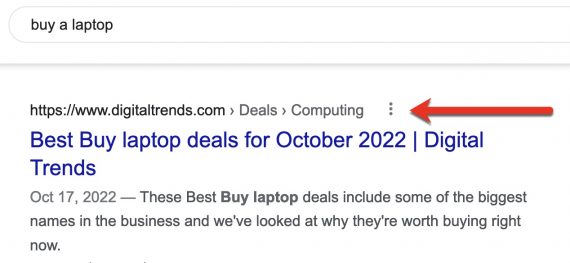Over the years Google has changed its search result pages, yet three elements of organic snippets remain:
- Title,
- URL,
- Description.
Here’s how Google’s standard snippets function and how to optimize them for more clicks.
Title
The title is the most visible part of the search snippet and the only clickable element from a desktop browser.
On a mobile device, the entire title and URL area is tappable. Image thumbnails are clickable (desktop) and tappable (mobile).
Hence titles presumably impact click-throughs. Google seems to confirm this, claiming titles are the “primary piece of information people use to decide which result to click on.”
For years Google used a page’s title tag on the search snippet. This changed in August 2021 when Google announced it would henceforth use multiple sources of info on a page when generating snippet titles. Thus Google may use for the snippet the most prominent headline of a page to align it with searchers’ expectations.
So there is much less control over the snippet’s title. But you can still optimize clicks by:
- Ensuring the page’s visible headline is the same as the title tag.
- Including target keywords in both — the page’s visible headline and title tag — since searchers look for the words they type. Avoid keyword stuffing, however, as Google could rewrite over-optimized titles.
- Focusing on the first 60 characters (roughly) of both the title tag and visible headline. Google may truncate the rest.
- Making your titles and headlines click-worthy.
URL
Google used to show the entire URL below the title of the snippet.
But the URL is now more like a breadcrumb indicating the linked page’s position in the site’s hierarchy. In my experience, Google typically determines this part of the snippet correctly without additional help.
Nonetheless, you can help ensure it’s accurate by using the BreadcrumbList schema type.

A snippet’s URL now resembles a breadcrumb indicating a page’s position in the site’s hierarchy, such as in this example from Digital Trends.
Description
The snippet’s description is usually two lines.
Google has extensive documentation on how to write good meta descriptions to help it generate useful snippets. But Google often ignores meta descriptions and uses on-page text based on each search query.
Yet meta descriptions remain helpful, especially when a page has little text. And Google claims to use meta descriptions if appropriate for the query.

Meta descriptions remain useful when relevant to a query, such as this example for “buy a laptop,” wherein those terms appear in bold.
To help Google generate helpful snippet descriptions:
- Include factual data in meta descriptions — all the details reflecting the page’s purpose that can fit in two lines — such as product names, prices, author, and key specifications. For example, the meta description for the home page of a local company should include the business’s name, location, hours, and key products and services.
- Add the target keywords to a page’s meta description, as they will appear in bold in the snippet. Bold text attracts searchers. But don’t overdo it.
- Ensure meta descriptions are not too short since Google occasionally uses them regardless of length. An example is a product category page with no text.
- Summarize in the meta description a page’s content, using meaningful conclusions and takeaways. This will also help it get featured.
- Use lists in meta descriptions. Google tends to use them in snippets.
- Structure a page using H2 and H3 headings. Google views the structure as a summary. Meaningfully include target keywords in those headings to increase the chances of bold text in search snippets.
More Snippets
There are many opportunities beyond standard snippets to generate clicks from organic search results. These include rich snippets, structured snippets, mini sitelinks, and image thumbnails.





